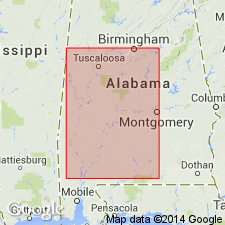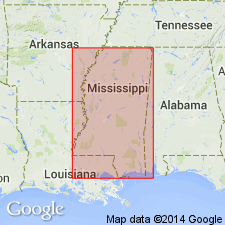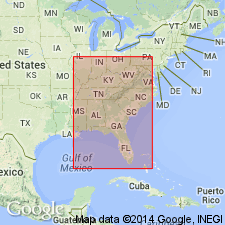
- Usage in publication:
-
- Naheola series*
- Modifications:
-
- Named
- Dominant lithology:
-
- Clay
- Sand
- AAPG geologic province:
-
- Mid-Gulf Coast basin
Summary:
Naheola and Matthew's Landing series described here as mostly gray sandy clays alternating with cross-bedded sands, with a bed (3 to 6 ft thick) at base of section containing marine fossils and consisting of glaucontic sands and dark-gray, nearly black sandy clays. Unconformable underlies Nanafalia series and overlies Black Bluff series [Sucarnoochee clay]. Thickness, 130 to 150 ft. [In subsequent reports, the basal marl bed, 3 to 6 ft thick, is called Naheola marl, or Matthew's Landing marl.]
Source: GNU records (USGS DDS-6; Reston GNULEX).

- Usage in publication:
-
- Naheola formation*
- Modifications:
-
- Overview
- AAPG geologic province:
-
- Mid-Gulf Coast basin
Summary:
Naheola formation of Midway group. Age is early Eocene. Recognized in southern Alabama and eastern Mississippi.
In present usage, the Naheola is top formation of Midway group, and is underlain by Sucarnoochee clay and overlain by Wilcox group. It is of marine origin. C.W. Cooke, 1933 (AAPG Bull. v. 17, no. 2, p 192-195), restricted Nanafalia formation to its upper two members, the lower member (†Coal Bluff beds of early reports) having proved to be an eastern extension of Ackerman formation, basal formation of Wilcox group of Mississippi. The beds that overlie the Naheola formation are therefore now called Ackerman formation.
Named from exposures at Naheola, on Tombigbee River, in Choctaw Co., southern AL.
Source: US geologic names lexicon (USGS Bull. 896, p. 1457-1457).

- Usage in publication:
-
- Naheola Formation
- Modifications:
-
- Revised
- AAPG geologic province:
-
- Black Warrior basin
Summary:
Fearn Springs is revised to member status in the Naheola Formation of the Midway Group in MS. Interpreted to be updip facies of the Oak Hill Member in AL. Name remains a useful term because of the mineral deposits exclusive to that facies. This revision changes the position of the Midway-Wilcox boundary in MS.
Source: GNU records (USGS DDS-6; Reston GNULEX).

- Usage in publication:
-
- Naheola Formation*
- Modifications:
-
- Biostratigraphic dating
- AAPG geologic province:
-
- Mid-Gulf Coast basin
Summary:
Naheola Formation shown as Paleocene (Midway) age on fig. 1. Midway age based on CRASSATELLA AQUIANA collected from Wilcox Co., central AL.
Source: GNU records (USGS DDS-6; Reston GNULEX).
For more information, please contact Nancy Stamm, Geologic Names Committee Secretary.
Asterisk (*) indicates published by U.S. Geological Survey authors.
"No current usage" (†) implies that a name has been abandoned or has fallen into disuse. Former usage and, if known, replacement name given in parentheses ( ).
Slash (/) indicates name conflicts with nomenclatural guidelines (CSN, 1933; ACSN, 1961, 1970; NACSN, 1983, 2005, 2021). May be explained within brackets ([ ]).

